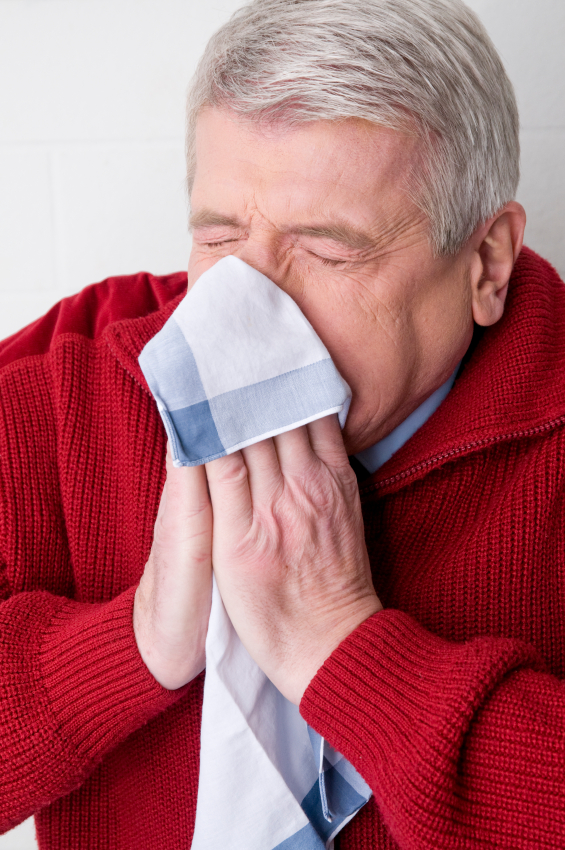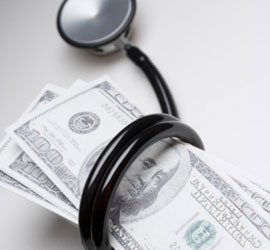New Season Brings New Allergies
October 10th, 2012 The leaves on the trees are turning colors and there is a nip in the air. Though people tend to breathe a sigh of relief because they believe with fall, allergy season is over, they shouldn't relax just yet.
The leaves on the trees are turning colors and there is a nip in the air. Though people tend to breathe a sigh of relief because they believe with fall, allergy season is over, they shouldn't relax just yet.
Fall Allergy Season
A number of experts are predicting that this fall will have more people sneezing than normal. This stems from the warm temperatures experienced this year. Fall allergy season typically lasts from mid-August until the first frost of the year, around early October.
- Ragweed: Typically begins to pollinate in mid-August and can linger well into the fall months.
- Mold: Damp leaves that line yards and streets in the fall are breeding grounds for mold
- Dust mites: An inside fall allergy, they can get stirred in the air the first time the furnace gets turned on in the fall.
The symptoms of fall allergies are:
- Sneezing
- Runny or stuffy nose
- Coughing
- Itchy throat
- Post nasal drip
- Circles under the eye
- Swollen, watery or itchy eyes
Asthma and Allergies
The fall season can expose people with asthma to unexpected triggers. Here are some tips on how to manage during the fall allergy season:
- Scarves: Cold air (temperature changes) can be an asthma trigger. Wrap a scarf around your mouth and nose to help warm the air you breathe.
- Stay Indoors: Stay indoors if the pollen count is high, between 10 am to 3 pm.
- Don't burn leaves: The smoke that comes from burning leaves contains a number of pollutants that can irritate the eyes, nose, throat, and lungs. These tiny particles can cause respiratory infections or trigger an asthma episode.
- Use the dryer: Don't use an outdoor clothes line to dry clothes where they might get dusted with pollen.
Treating Fall Allergies
There may not be a cure for fall allergies, but there are different types of treatments:
- Prescription Corticosteroids: These are usually given in the form of a nasal spray to reduce the inflammation in the nose.
- Antihistamines: Reduces sneezing, sniffling, and itching by blocking the action of the histamine (the substance produced during an allergic reaction) in the body.
- Decongestants: Clears mucus out of the nasal passageways to relieve congestion and swelling.
- Allergy Shots: Exposes your body to gradually increasing doses of the allergen until you become tolerant.
If you know you have fall allergies, take medication before symptoms begin.
What IAA has to Say
Don't let your allergies get the better of you this fall season! Talk to your doctor about what type of treatment would work for you. Insurance Administrator of America wants you to go outside and enjoy fall. Remember, with IAA, one call does it all.
Like this blog post on Facebook!
Healthcare 2.0: New Tools For The Healthcare Industry
October 3rd, 2012 When people think about social media they tend to think of the "social" aspect of it. People tend to use Twitter, Facebook, and other platforms as a way to connect with friends. What people don't normally think about when publishing their latest blog post, is their doctor. That is beginning to change. The world of healthcare is changing as the world of social media is becoming increasingly larger.
When people think about social media they tend to think of the "social" aspect of it. People tend to use Twitter, Facebook, and other platforms as a way to connect with friends. What people don't normally think about when publishing their latest blog post, is their doctor. That is beginning to change. The world of healthcare is changing as the world of social media is becoming increasingly larger.
A New Breed of Physician
Social media makes it easier than ever for patients and physicians to connect outside the exam room. Physicians are realizing that their patients want more than just a 15 minute office visit. This has led to a new breed of physician that is texting health messages to patients, tracking disease trends on Twitter, identifying medical problems on Facebook pages, and communicating with patients through email.
Not every doctor however, is on board. One of the main reasons physicians give for not using social media is they do not want to be in danger of violating HIPPA. The American Medical Association (AMA) feels that new technology creates new challenges in the patient-physician relationship. The AMA has come up with the following guidelines:
- Physicians should be cognizant of standards of patient privacy and confidentiality that must be maintained in all environments, including online, and must refrain from posting identifiable patient information online.
- When using the Internet for social networking, physicians should use privacy settings to safeguard personal information.
- When physicians see content posted by colleagues that appears unprofessional, they have a responsibility to bring that content to the attention of the individual, so that he or she can remove it and/or take other appropriate actions.
Healthcare Facilities Are Reaching Out
Hospitals and other healthcare facilities are finding social media an essential channel for customer engagement. Social media platforms help hospital employees learn what patients, physicians, and business partners are saying about their facility. This type of feedback can help hospital administration improve policies and processes.
In October of 2010, there were 17,871 U.S. hospitals using at least one form of social media technology. Social media is all about relationships and relationships are crucial to health. If patients have a good relationship with their healthcare providers, it helps them receive better healthcare. By healthcare facilities finding ways for providers and patients to have conversations via social media, they help strengthen and support those relationships.
What IAA has to Say
Insurance Administrator of America is excited to report on these changes in the healthcare industry and will keep you updated when new information becomes available. Remember, with IAA, one call does it all.
Number of Uninsured Decline, But Premiums Go Up
September 25th, 2012 On September 12, 2012, a report published by the U.S. Census Bureau found that the number of uninsured fell from 50 million in 2010 to 48.6 million in 2011. The downside--a report put out by the Kaiser Family Foundation found that insurance premiums have been on the rise since 2009.
On September 12, 2012, a report published by the U.S. Census Bureau found that the number of uninsured fell from 50 million in 2010 to 48.6 million in 2011. The downside--a report put out by the Kaiser Family Foundation found that insurance premiums have been on the rise since 2009.
Number of Uninsured Fall
For the first time since 2007, the number of people without health insurance fell. Census officials attribute the decline to two major factors: more young adults are staying on their parents insurance and more people are enrolled in government insurance programs.
The biggest drop in the uninsured was among people ages 19 to 25. The rate fell from 29.8% in 2010 to 27.7% in 2011. This is the second consecutive year that this age group has seen at least a 2% decline. Health experts credit a provision in the federal health law which allows families to keep children on their healthcare plan up to age 26. The Obama Administration has stated that about 2 million people have gained coverage from this provision.
The federal healthcare law has another provision called "maintenance of effort" provision which has blocked states from making it harder for people to qualify for Medicaid. The percent of people covered by Medicaid rose from 48.5 million or 15.8% of the population in 2010 to 50.8 million or 16.5% of the population in 2011. Overall, the percent of people covered by government sponsored programs rose to nearly 100 million in 2011 or 32% of the population, compared to 31% of the population in 2010. This is the fifth consecutive year that the numbers in government insurance programs have risen.
The Obama Administration has stated that consumers have saved 2.1 billion dollars in premiums due to the federal healthcare law. 1.1 billion comes from the estimated Medical Loss Ratio (MLR) rebates (which not everyone qualified for). The remaining 1 billion dollars was attributed to the law's rate review provisions, which protects individuals and small businesses from unreasonable insurance rate increases.
A Rise in Premiums
While the Obama Administration states that consumers are saving money on their premiums, the Kaiser Family Foundation conducted a study stating that the average American covered by employer-funded insurance is paying $700 more in premium costs, thus showing different results than the Obama Administration.
In the Kaiser Family Foundation study, researchers found that premiums for a family plan are now averaging $15,745 with employees paying more than $4,300 of that. This is an increase of about 4% from over a year ago.
The numbers above may show a historically moderate increase in premiums, but they can feel big to workers when wages are flat or falling.
What IAA has to Say
These numbers can seem confusing, but Insurance Administrator of America is here to help. IAA works closely with employers and brokers to provide a customized plan that works for employers and their employees. With IAA you don't have to work within the confines of a traditional health insurance plan. Let IAA help create the perfect plan for your company. Remember, with IAA, one call does it all.
If you would like to read more blog posts about the PPACA click here and here.
Preventing Youth Sports Injuries
September 19th, 2012 According to the Center for Disease Control and Prevention (CDC) nearly 30 million children and adolescents participate in youth sports in the United States. Insurance Administrator of America is here with information to help those little (and not so little) athletes.
According to the Center for Disease Control and Prevention (CDC) nearly 30 million children and adolescents participate in youth sports in the United States. Insurance Administrator of America is here with information to help those little (and not so little) athletes.
Common Sports Injuries
Children ages 5 to 14 account for nearly 40% of all sports injuries treated in hospitals. Accidents, poor training practices, improper gear, and not warming up or stretching long enough, can cause injuries. The most common sports injuries are:
- Sprains and strains
- Knee Injuries
- Swollen Muscles
- Achilles tendon injuries
- Pain along the shin bone
- Fractures
- Dislocations
Most injuries are first treated with RICE:
- Rest
- Ice
- Compression
- Elevation
What Parents Can Do
According to the CDC, more than half of all sports injuries are preventable. What can parents do to help make sure their children are safe?
-
Annual pre-participation evaluation: This evaluation by a doctor helps determine readiness to play sports and uncovers any underlying conditions that could limit participation or increase the risk of injury or a medical emergency.
-
Hydration: Encourage drinking water before, during, and after practice.
-
Protective Equipment: Parents can reduce minor or serious injuries by making sure their child wears appropriate protective equipment. Check to make sure equipment fits and for wear and tear.
Overtraining
Parents can also help by making sure that their child does not specialize in a sport too early. The American Academy of Pediatrics states that kids should not specialize in one specific sport before adolescence. This can cause overtraining. Signs of overtraining are:
- Slower times in distance sports.
- Decreased ability to achieve training goals.
- Deterioration in executing sports plays and routines.
- Lack of motivation to practice.
- Getting tired easily.
- Inability and unwilling to cooperate with teammates.
As a general rule, children shouldn't train for more than 18 to 20 hours a week. Parents need to encourage their children to strive for a balance. Kids will take their cues from parents, so if you set a limit, let them know you mean it.
What IAA has to Say
Youth sports programs are a great way to add physical activity to your child's day. IAA is a proud sponsor of youth sports programs. IAA is also proud to announce its 20th anniversary. IAA has been privileged to help clients and client members for these past twenty years. IAA is still happy to say, one call does it all.
Like this blog post on Facebook!
Packing Healthy Back to School Lunches
September 12th, 2012 Now that kids are back in school, parents have the overwhelming task of packing lunches. It can be hard making healthy lunches knowing your children are picky eaters. Insurance Administrator of America is here to offer some advice that will make packing lunches a little easier.
Now that kids are back in school, parents have the overwhelming task of packing lunches. It can be hard making healthy lunches knowing your children are picky eaters. Insurance Administrator of America is here to offer some advice that will make packing lunches a little easier.
Before Packing Lunch
When planning lunches, ask for your child's input. Kids tend to be more adventurous with food when they are involved. Allow them to come shopping with you and point out healthy items that you can pack in their lunch box. They might be more eager to eat that piece of fruit if they pick it out themselves.
Try having your children pre-select their lunch from a list of healthy choices. The more control your child feels he has, the more willing he could be to try healthier items. After they choose from the list, allow them to help with the preparation process. Having fun with their food will make them all the more eager to eat it.
Create Great Brain Boosting Lunches
Your child may be willing to eat healthier food, but what should you pack? When you pack foods that help stimulate brain activity, it makes it easier for your child to concentrate in class. Some good choices are:
- Fish: Contains omega3 fatty acids which protects the brain and assists with learning and memory. Try packing tuna or salmon salad.
- Protein: Contributes in the creation of neurotransmitters, which carry vital messages from the brain to the rest of the body. Try packing grilled chicken, sliced turkey breast or other lean meats which are good sources of protein that can be added to sandwiches or salads.
- Whole grains: Fiber and iron will slowly release energy to the body to help with constant focus. Try using whole grain bread instead of white.
- Raw Vegetables: Many vegetables can help protect the brain. Carrot and celery sticks are always a good addition to any lunch box.
A healthy school lunch combines nutrient-rich foods from several food groups to supply protein, fat, and carbohydrates to sustain energy and concentration for several hours.
Make Lunch Interactive
Everyone knows that children love to play with their food, so make lunch a playful experience! Here are a few tips to turn those healthy choices into fun ones:
- Cookie Cutters: Use cookie cutters to cut sandwiches into different characters. Your child might have an easier time eating whole grain bread if it's in the shape of a teddy bear.
- Create your own version of their favorites: Do your children love Lunchables? Try making your own healthier version. Choose whole grain crackers, lean meats, and their favorite cheese. Your child can have the fun of putting it together.
- Crunch Time: Kids love to crunch, so pack them a healthy lunch they can crunch on. Try packing a tuna salad with whole grain crackers. They can crunch and dip all at the same time.
A basic lunch usually consists of a main dish, a fruit or vegetable, possibly a healthy dessert, and a low calorie beverage. Try making your child's lunch as fun and interactive as possible.
What IAA has to Say
IAA wants you and your children to have fun while making their lunch. IAA also wants you to start thinking about what you pack for your lunch. Your child doesn't have to be the only healthy eater in the house. Just think of IAA as your kitchen helper, making sure everyone leaves the house with a healthy lunch.
To read another blog post on this topic click here.
